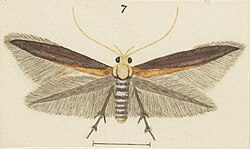Biology:Stathmopoda endotherma
| Stathmopoda endotherma | |
|---|---|

| |
| Illustration of female | |
| Scientific classification | |
| Domain: | Eukaryota |
| Kingdom: | Animalia |
| Phylum: | Arthropoda |
| Class: | Insecta |
| Order: | Lepidoptera |
| Family: | Stathmopodidae |
| Genus: | Stathmopoda |
| Species: | S. endotherma
|
| Binomial name | |
| Stathmopoda endotherma Meyrick, 1931[1]
| |
Stathmopoda endotherma is a species of moth in the family Stathmopodidae. It is endemic to New Zealand. It is classified as "At Risk, Naturally Uncommon" by the Department of Conservation.
Taxonomy
This species was described by Edward Meyrick in 1931 using a specimen collected at Little River, Banks Peninsula in January by Stewart Lindsay.[2][3] George Hudson discussed and illustrated the species in his 1939 book A supplement to the butterflies and moths of New Zealand.[4] The holotype specimen is held at the Canterbury Museum.[2]
Description
Meyrick described the species as follows:
♀︎. 13-14mm. Head, palpi brassy-whitish-ochreous. Thorax pale brassy-orange-ochreous. Forewings rather narrow, long-pointed ; bronze-grey ; an orange basal mark from costa to fold ; dorsal area as far as fold orange mixed ferruginous, slightly tinged grey near base ; an obscure suffused ferruginous supramedian streak from 1⁄5 to beyond middle ; cilia light bronzy-grey. Hindwings grey ; cilia light grey.[3]
Distribution
This species is endemic to New Zealand.[1][5] As well as the type locality, this species has also been collected at Akaroa, Riccarton Bush, Prices Valley at Banks Peninsula, Klondyke Corner at Arthurs Pass National Park, McQuilkans Creek at Swampy Summit near Dunedin, and Dunsdale Scenic Reserve in Southland.[6][7]
Biology and life cycle
This species is on the wing between late October and January.[3][7]
Host species and habitat
As this moth belongs to the genus Stathmopoda its larvae, like those of other species in the genus, may feed on scale insects.[7] The preferred habitat of this species is indigenous forest.[7]
Conservation status
This species has been classified as having the "At Risk, Naturally Uncommon" conservation status under the New Zealand Threat Classification System.[8]
References
- ↑ 1.0 1.1 "Stathmopoda endotherma Meyrick, 1931". Landcare Research New Zealand Ltd. http://www.nzor.org.nz/names/ea080d65-1e29-4cf3-86c6-f0ad206a92a3.
- ↑ 2.0 2.1 Dugdale, J. S. (1988). "Lepidoptera - annotated catalogue, and keys to family-group taxa". Fauna of New Zealand 14: 108. https://www.landcareresearch.co.nz/__data/assets/pdf_file/0017/26324/FNZ14Dugdale1988.pdf. Retrieved 2018-05-26.
- ↑ 3.0 3.1 3.2 Meyrick, Edward (1931). "Notes on New Zealand Lepidoptera.". Records of the Canterbury Museum 3: 367–369. http://www.bugz.org.nz/WebForms/ResultDetails.aspx?CurrentDoc=204A4AE0-8E0D-4043-BDE9-BE8E2F7D3F42&back=true&NewDoc=true&searchType=4&SearchString=Stathmopoda+endotherma.
- ↑ Hudson, G. V. (1939). A supplement to the butterflies and moths of New Zealand.. Wellington: Ferguson & Osborn. pp. 456. OCLC 9742724. http://www.bugz.org.nz/WebForms/ResultDetails.aspx?CurrentDoc=4A102474-EF01-4089-A31A-A1FE7E551E52&back=true&NewDoc=true&searchType=1&SearchString=G.V.+Hudson.
- ↑ Gordon, Dennis P., ed (2010). New Zealand inventory of biodiversity. Volume two. Kingdom animalia : chaetognatha, ecdysozoa, ichnofossils. 2. Christchurch, N.Z.: Canterbury University Press. pp. 463. ISBN 9781877257933. OCLC 973607714.
- ↑ Hogan, Debbie (6 June 2017). "Christchurch District Plan. Site of Ecological Significance. Stony Beach.". https://districtplan.ccc.govt.nz/Images/DistrictPlanImages/Site%20of%20Ecological%20Significance/SES%20A%2027.pdf.
- ↑ 7.0 7.1 7.2 7.3 Patrick, Brian (2014). "Conservation status of five data deficient moth taxa: Epichorista lindsayi, "Cnephasia" paterna, Stathmopoda endotherma, Gymnobathra ambigua and Scythris "stripe"". The Weta 48: 15–35. http://publications.ento.org.nz/index.php/weta/issue/download/5/full%20issue%20Weta%2048.
- ↑ Hoare, R.J.B.; Dugdale, J.S.; Edwards, E.D.; Gibbs, G.W.; Patrick, B.H.; Hitchmough, R.A.; Rolfe, J.R. (2017). "Conservation status of New Zealand butterflies and moths (Lepidoptera), 2015". New Zealand Threat Classification Series 20: 8. http://www.doc.govt.nz/Documents/science-and-technical/nztcs20entire.pdf.
External links
Wikidata ☰ Q14383232 entry
 |

